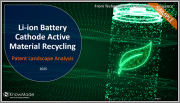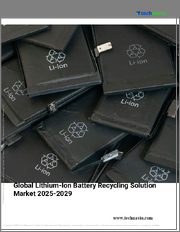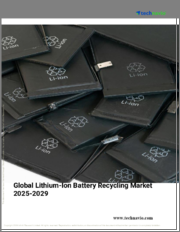
|
시장보고서
상품코드
1766055
세계의 리튬 이온 배터리 재활용 시장 예측 : 화학, 프로세스, 공급원, 기술, 최종 사용자, 지역별 분석(-2032년)Li-ion Battery Recycling Market Forecasts to 2032 - Global Analysis By Chemistry, Process, Source, Technology, End User and By Geography |
||||||
Stratistics MRC에 따르면 세계 리튬 이온 배터리 재활용 시장은 2025년 86억 달러, 예측 기간 동안 CAGR 20.6%로 성장하고, 2032년에는 322억 달러에 이를 전망입니다.
리튬 이온 배터리 재활용은 사용된 리튬 이온 배터리에서 귀중한 재료를 회수하고 폐기물 및 환경에 미치는 영향을 줄이는 과정입니다. 전기, 파쇄, 양극, 음극, 전해질 등의 부품이 분리됩니다. 그 후, 화학 공정에 의해 금속이 정제되어 전지 제조에 재이용됩니다.
세계 경제 포럼에 따르면 배터리 시장은 2021년에 세계 리튬 생산량의 약 74%를 소비하여 효율적인 재활용 솔루션의 중요한 필요성을 부각하고 있습니다.
세계의 전기차 보급 증가
전기자동차(EV) 세계의 급속한 보급은 리튬 이온 배터리 재활용 시장의 최대 촉진요인입니다. 배터리의 엄청난 미래 공급으로 이어지고 있습니다. 이 "배터리 더미"가 증가함에 따라 견고한 재활용 인프라와 귀중한 재료를 재생하는 효율적인 프로세스가 시급합니다.
표준화된 재활용 인프라 부족
리튬 이온 배터리의 재활용 시장에 중요한 억제요인은 표준화된 종합적인 재활용 인프라가 보급되지 않는 것입니다. 많은 지역에서 수거 지점과 전문 재활용 시설만으로는 빠르게 증가하는 수명이 다한 배터리를 처리하기에 충분하지 않습니다. 재활용에 대한 명확한 규제 프레임 워크와 경제적 인센티브가 없으면 견고한 인프라를 확립하는 것을 더욱 방해하고 있습니다.
재활용 기술의 발전
리튬 이온 배터리의 재활용 시장에 있어서 큰 기회가 되는 것은 리사이클 기술의 진보입니다. 보다 높은 회수율, 보다 낮은 에너지 소비, 환경에 미치는 영향을 줄이는 새로운 기술이 출현하고 있습니다.
신형 배터리와의 경쟁
리튬 이온 배터리의 재활용 시장에 큰 위협이 되는 것은 새로운 화학적 진화를 이룬 배터리와의 경쟁입니다. 그렇게 되면 리튬 이온 배터리의 장기 생산 수요가 줄어들어 재활용에 사용할 수 있는 배터리의 양에 영향을 줄 수 있으며, 재료 조성이 다른 화학물질로의 전환으로 인해 현재의 재활용 프로세스가 늦어지거나 효율이 저하되어 많은 투자가 필요할 수 있습니다.
COVID-19의 영향
COVID-19의 대유행은 리튬 이온 전지 재활용 시장에 다양한 영향을 주었지만, 궁극적으로는 가속했습니다. 처음에는 공급망의 혼란과 자동차 생산과 소비자용 전자기기 판매의 일시적인 감속에 의해 재활용 전지의 생산량은 약간 떨어졌습니다. 세계 공급망의 취약성을 부각시켰습니다. 이 때문에 순환형 경제의 확립과 원료의 국내 공급 확보에 다시 초점을 맞추어 배터리 재활용에 장기적인 관심과 투자가 높아졌습니다.
예측 기간 동안 산화 코발트리튬 부문이 최대가 될 것으로 예상
산화코발트리튬(LCO) 배터리는 스마트폰, 노트북, 태블릿 등의 소비자용 전자기기 제품에 폭넓게 사용되고 있기 때문에 예측 기간 동안 산화코발트리튬 부문이 최대 시장 점유율을 차지할 것으로 예측됩니다. 따라서 재활용을 위한 안정적인 중요한 원료가 확보됩니다. LCO 배터리는 또한 고농도로 귀중하고 중요한 재료가 포함되어 있기 때문에 재활용은 경제적으로 매력적입니다.
고온 야금 부문은 예측 기간 중 가장 높은 CAGR이 예상된다.
예측 기간 동안 고온 야금 부문이 가장 높은 성장률을 보일 것으로 예측됩니다. 그 간편함과 전처리 요건의 감소에 영향을 받고 있으며, 이 기술은 계속 투자를 모으고 있습니다.
최대 점유율을 차지하는 지역
예측기간 동안 아시아태평양이 가장 큰 시장 점유율을 차지할 것으로 예상되며, 이는 전자폐기물과 산업의 지속가능성에 관한 정부의 지령이 뒷받침하고 있습니다. EV의 적극적인 보급과 도시화가 박차를 가하고, 배터리 폐기물의 양이 급속히 증가하고 있습니다.
CAGR이 가장 높은 지역
예측 기간 동안 북미가 가장 높은 CAGR을 나타낼 것으로 예측됩니다. 강력한 목표와 제조업체의 헌신으로 이어져 재활용 재료에 대한 수요가 급증하고 있습니다.
무료 맞춤형 서비스
이 보고서를 구독하는 고객은 다음 무료 맞춤설정 옵션 중 하나를 사용할 수 있습니다.
- 기업 프로파일
- 추가 시장 진출기업의 종합적 프로파일링(3개사까지)
- 주요 기업의 SWOT 분석(3개사까지)
- 지역 세분화
- 고객의 관심에 응한 주요국 시장 추정, 예측, CAGR(주 : 타당성 확인에 따름)
- 경쟁 벤치마킹
- 제품 포트폴리오, 지리적 존재, 전략적 제휴를 통한 주요 기업 벤치마킹
목차
제1장 주요 요약
제2장 서문
- 개요
- 이해관계자
- 조사 범위
- 조사 방법
- 데이터 마이닝
- 데이터 분석
- 데이터 검증
- 조사 접근
- 조사 자료
- 1차 조사 자료
- 2차 조사 자료
- 전제조건
제3장 시장 동향 분석
- 소개
- 성장 촉진요인
- 억제요인
- 기회
- 위협
- 기술 분석
- 최종 사용자 분석
- 신흥 시장
- COVID-19의 영향
제4장 Porter's Five Forces 분석
- 공급기업의 협상력
- 구매자의 협상력
- 대체품의 위협
- 신규 참가업체의 위협
- 경쟁 기업간 경쟁 관계
제5장 세계의 리튬 이온 배터리 재활용 시장 : 화학별
- 소개
- 코발트산리튬
- 인산철 리튬
- 망간산 리튬
- 리튬 니켈 코발트 알루미늄 산화물
- 리튬 니켈 망간 코발트 산화물
제6장 세계의 리튬 이온 배터리 재활용 시장 : 프로세스별
- 소개
- 고온 야금
- 습식 야금
- 물리적/기계적
제7장 세계의 리튬 이온 배터리 재활용 시장 : 공급원별
- 소개
- 자동차
- 자동차 이외
제8장 세계의 리튬 이온 배터리 재활용 시장 : 기술별
- 소개
- 습식 야금
- 고온 야금
- 물리적/기계적
- 직접 재활용
제9장 세계의 리튬 이온 배터리 재활용 시장 : 최종 사용자별
- 소개
- 자동차
- 소비자용 전자 기기
- 통신과 기술
- 에너지 및 전력
- 기타
제10장 세계의 리튬 이온 배터리 재활용 시장 : 지역별
- 소개
- 북미
- 미국
- 캐나다
- 멕시코
- 유럽
- 독일
- 영국
- 이탈리아
- 프랑스
- 스페인
- 기타 유럽
- 아시아태평양
- 일본
- 중국
- 인도
- 호주
- 뉴질랜드
- 한국
- 기타 아시아태평양
- 남미
- 아르헨티나
- 브라질
- 칠레
- 기타 남미
- 중동 및 아프리카
- 사우디아라비아
- 아랍에미리트(UAE)
- 카타르
- 남아프리카
- 기타 중동 및 아프리카
제11장 주요 개발
- 계약, 파트너십, 협업, 합작투자
- 인수와 합병
- 신제품 발매
- 사업 확대
- 기타 주요 전략
제12장 기업 프로파일링
- 3R Recycler
- ACE Green Recycling
- American Battery Technology Company
- Attero Recycling
- BatX Energies
- Cirbra Solution
- Ganfeng Lithium
- Glencore
- Li-Cycle Holdings Corporation
- Lohum Cleantech
- Neometals
- RecycLiCo Battery Material
- Redwood Materials
- SK TES
- Umicore
According to Stratistics MRC, the Global Li-ion Battery Recycling Market is accounted for $8.6 billion in 2025 and is expected to reach $32.2 billion by 2032 growing at a CAGR of 20.6% during the forecast period. Li-ion battery recycling is the process of recovering valuable materials from spent lithium-ion batteries to reduce waste and environmental impact. It involves mechanical dismantling, thermal treatment, and hydrometallurgical processing to extract lithium, cobalt, nickel, and other metals. Batteries are first discharged and shredded, followed by separation of components like cathodes, anodes, and electrolytes. Chemical processes then refine metals for reuse in battery manufacturing. Efficient recycling requires advanced sorting, purification, and recovery technologies to optimize material yield and minimize hazardous byproducts.
According to the World Economic Forum, the battery market consumed approximately 74% of global lithium production in 2021, highlighting the critical need for efficient recycling solutions.
Market Dynamics:
Driver:
Rising electric vehicle adoption globally
The surging global adoption of electric vehicles (EVs) is the foremost driver for the Li-ion battery recycling market. As EV sales continue to break records, the volume of end-of-life Li-ion batteries requiring environmentally responsible disposal and resource recovery is rapidly increasing. Governments worldwide are promoting EV adoption through incentives and regulations, leading to a vast future supply of spent batteries. This growing "battery mountain" creates an urgent need for robust recycling infrastructure and efficient processes to reclaim valuable materials. The shift towards sustainable transportation, spurred by climate change mitigation efforts, directly fuels the demand for battery recycling.
Restraint:
Lack of standardized recycling infrastructure
A significant restraint for the Li-ion battery recycling market is the prevalent lack of a standardized and comprehensive recycling infrastructure. The diverse chemistries and designs of Li-ion batteries make universal recycling processes challenging and costly. In many regions, collection points and specialized recycling facilities are insufficient to handle the rapidly increasing volume of end-of-life batteries. The absence of clear regulatory frameworks and economic incentives for recycling further impedes the establishment of a robust infrastructure. This fragmented landscape creates logistical bottlenecks and hinders the efficient flow of batteries into the recycling pipeline.
Opportunity:
Advancements in recycling tech
A major opportunity for the Li-ion battery recycling market stems from ongoing advancements in recycling technologies. Innovations in hydrometallurgical, pyrometallurgical, and direct recycling methods are improving the efficiency and economic viability of extracting valuable materials like lithium, cobalt, and nickel. New techniques are emerging that offer higher recovery rates, lower energy consumption, and reduced environmental impact. These technological leaps are crucial for scaling up recycling operations and making them more profitable, fueled by the demand for critical raw materials.
Threat:
Competition from new battery types
A considerable threat to the Li-ion battery recycling market is the emergence and growing competition from new and evolving battery chemistries. While Li-ion batteries currently dominate, ongoing research is exploring alternatives like solid-state batteries, sodium-ion batteries, and flow batteries. If these new battery types achieve widespread commercialization, they could reduce the long-term demand for Li-ion battery production, consequently impacting the volume of batteries available for recycling. The shift to chemistries with different material compositions might also render current recycling processes obsolete or less efficient, requiring significant new investments.
Covid-19 Impact:
The COVID-19 pandemic had a mixed but ultimately accelerating impact on the Li-ion battery recycling market. Initially, supply chain disruptions and a temporary slowdown in automotive production and consumer electronics sales led to a slight dip in battery generation for recycling. However, the pandemic also highlighted the fragility of global supply chains for critical raw materials. This prompted a renewed focus on establishing circular economies and securing domestic supplies of materials, thereby boosting long-term interest and investment in battery recycling. The accelerated shift towards electric vehicles post-pandemic further underscored the urgent need for a robust recycling infrastructure.
The lithium cobalt oxide segment is expected to be the largest during the forecast period
The lithium cobalt oxide segment is expected to account for the largest market share during the forecast period, due to the extensive use of Lithium Cobalt Oxide (LCO) batteries in consumer electronics, such as smartphones, laptops, and tablets. The sheer volume of these devices reaching their end-of-life ensures a consistent and significant feedstock for recycling. LCO batteries also contain high concentrations of cobalt, a valuable and critical material, making their recycling economically attractive. Their pervasive presence in the consumer sector solidifies their leading market share.
The pyrometallurgical segment is expected to have the highest CAGR during the forecast period
Over the forecast period, the pyrometallurgical segment is predicted to witness the highest growth rate, backed by established industrial applications and infrastructure, this method ensures efficient metal recovery through high-temperature smelting. By increasing adoption in large-scale commercial recycling plants, pyrometallurgy remains a preferred solution in emerging economies. Influenced by its simplicity and reduced preprocessing requirements, this technique continues to attract investment. Guided by improvements in emission control technologies, environmental compliance is becoming more achievable. Motivated by expanding demand for streamlined, high-output recycling, the segment is projected to register the highest CAGR.
Region with largest share:
During the forecast period, the Asia Pacific region is expected to hold the largest market share, fuelled by government mandates on e-waste and industrial sustainability. Nations like China, South Korea, and Japan lead recycling infrastructure development. Guided by the presence of leading battery manufacturers, the region enjoys a well-integrated ecosystem. Spurred by aggressive EV adoption and urbanization, battery waste volumes are increasing rapidly. Motivated by resource scarcity, local governments are enforcing circular economy policies. Influenced by cost-competitive recycling services and strong supply chains, Asia Pacific will retain the largest market share.
Region with highest CAGR:
Over the forecast period, the North America region is anticipated to exhibit the highest CAGR, influenced by critical mineral sourcing concerns, and battery recycling is becoming a strategic national priority. Backed by growing investment in advanced recycling startups, the U.S. and Canada are fostering innovation-led growth. Guided by strong automotive electrification goals and manufacturer commitments, demand for recycled materials is surging. Spurred by new legislation supporting closed-loop recycling systems, infrastructure is expanding rapidly. Motivated by increasing collaboration between automakers and recyclers, the region is set to lead in growth momentum.
Key players in the market
Some of the key players in Li-ion Battery Recycling Market include 3R Recycler, ACE Green Recycling, American Battery Technology Company, Attero Recycling, BatX Energies, Cirbra Solution, Ganfeng Lithium, Glencore, Li-Cycle Holdings Corporation, Lohum Cleantech, Neometals, RecycLiCo Battery Material, Redwood Materials, SK TES, and Umicore.
Key Developments:
In May 2025, Li-Cycle Holdings Corporation launched its Spoke & Hub 2.0 System, expanding recycling capacity across North America and Europe. The system's modular design enhances efficiency, recovering 95% of battery materials. It supports the EV and energy storage markets, reducing landfill waste and providing sustainable raw materials for battery production.
In April 2025, Ganfeng Lithium introduced a Closed-Loop Recycling Process, achieving 95% recovery of lithium, cobalt, and nickel. The process minimizes waste and energy use, supporting sustainable battery production. Its scalability benefits EV and renewable energy sectors, strengthening Ganfeng's position in the global supply chain for critical battery materials.
In March 2025, American Battery Technology Company (ABTC) announced its Lithium-Ion Direct Extraction Plant, cutting recycling costs by 30%. The plant uses proprietary technology to recover high-purity materials, supporting EV and grid storage industries. Its cost efficiency and high recovery rates make it a key player in sustainable battery recycling solutions.
Chemistries Covered:
- Lithium Cobalt Oxide
- Lithium Iron Phosphate
- Lithium Manganese Oxide
- Lithium Nickel Cobalt Aluminum Oxide
- Lithium Nickel Manganese Cobalt Oxides
Processes Covered:
- Pyrometallurgical
- Hydrometallurgical
- Physical/Mechanical
Sources Covered:
- Automotive
- Non-Automotive
Technologies Covered:
- Hydrometallurgical
- Pyrometallurgical
- Physical/Mechanical
- Direct Recycling
End Users Covered:
- Automotive
- Consumer Electronics
- Communication & Technology
- Energy & Power
- Other End Users
Regions Covered:
- North America
- US
- Canada
- Mexico
- Europe
- Germany
- UK
- Italy
- France
- Spain
- Rest of Europe
- Asia Pacific
- Japan
- China
- India
- Australia
- New Zealand
- South Korea
- Rest of Asia Pacific
- South America
- Argentina
- Brazil
- Chile
- Rest of South America
- Middle East & Africa
- Saudi Arabia
- UAE
- Qatar
- South Africa
- Rest of Middle East & Africa
What our report offers:
- Market share assessments for the regional and country-level segments
- Strategic recommendations for the new entrants
- Covers Market data for the years 2024, 2025, 2026, 2028, and 2032
- Market Trends (Drivers, Constraints, Opportunities, Threats, Challenges, Investment Opportunities, and recommendations)
- Strategic recommendations in key business segments based on the market estimations
- Competitive landscaping mapping the key common trends
- Company profiling with detailed strategies, financials, and recent developments
- Supply chain trends mapping the latest technological advancements
Free Customization Offerings:
All the customers of this report will be entitled to receive one of the following free customization options:
- Company Profiling
- Comprehensive profiling of additional market players (up to 3)
- SWOT Analysis of key players (up to 3)
- Regional Segmentation
- Market estimations, Forecasts and CAGR of any prominent country as per the client's interest (Note: Depends on feasibility check)
- Competitive Benchmarking
- Benchmarking of key players based on product portfolio, geographical presence, and strategic alliances
Table of Contents
1 Executive Summary
2 Preface
- 2.1 Abstract
- 2.2 Stake Holders
- 2.3 Research Scope
- 2.4 Research Methodology
- 2.4.1 Data Mining
- 2.4.2 Data Analysis
- 2.4.3 Data Validation
- 2.4.4 Research Approach
- 2.5 Research Sources
- 2.5.1 Primary Research Sources
- 2.5.2 Secondary Research Sources
- 2.5.3 Assumptions
3 Market Trend Analysis
- 3.1 Introduction
- 3.2 Drivers
- 3.3 Restraints
- 3.4 Opportunities
- 3.5 Threats
- 3.6 Technology Analysis
- 3.7 End User Analysis
- 3.8 Emerging Markets
- 3.9 Impact of Covid-19
4 Porters Five Force Analysis
- 4.1 Bargaining power of suppliers
- 4.2 Bargaining power of buyers
- 4.3 Threat of substitutes
- 4.4 Threat of new entrants
- 4.5 Competitive rivalry
5 Global Li-ion Battery Recycling Market, By Chemistry
- 5.1 Introduction
- 5.2 Lithium Cobalt Oxide
- 5.3 Lithium Iron Phosphate
- 5.4 Lithium Manganese Oxide
- 5.5 Lithium Nickel Cobalt Aluminum Oxide
- 5.6 Lithium Nickel Manganese Cobalt Oxide
6 Global Li-ion Battery Recycling Market, By Process
- 6.1 Introduction
- 6.2 Pyrometallurgical
- 6.3 Hydrometallurgical
- 6.4 Physical/Mechanical
7 Global Li-ion Battery Recycling Market, By Source
- 7.1 Introduction
- 7.2 Automotive
- 7.3 Non-Automotive
8 Global Li-ion Battery Recycling Market, By Technology
- 8.1 Introduction
- 8.2 Hydrometallurgical
- 8.3 Pyrometallurgical
- 8.4 Physical/Mechanical
- 8.5 Direct Recycling
9 Global Li-ion Battery Recycling Market, By End User
- 9.1 Introduction
- 9.2 Automotive
- 9.3 Consumer Electronics
- 9.4 Communication & Technology
- 9.5 Energy & Power
- 9.6 Other End Users
10 Global Li-ion Battery Recycling Market, By Geography
- 10.1 Introduction
- 10.2 North America
- 10.2.1 US
- 10.2.2 Canada
- 10.2.3 Mexico
- 10.3 Europe
- 10.3.1 Germany
- 10.3.2 UK
- 10.3.3 Italy
- 10.3.4 France
- 10.3.5 Spain
- 10.3.6 Rest of Europe
- 10.4 Asia Pacific
- 10.4.1 Japan
- 10.4.2 China
- 10.4.3 India
- 10.4.4 Australia
- 10.4.5 New Zealand
- 10.4.6 South Korea
- 10.4.7 Rest of Asia Pacific
- 10.5 South America
- 10.5.1 Argentina
- 10.5.2 Brazil
- 10.5.3 Chile
- 10.5.4 Rest of South America
- 10.6 Middle East & Africa
- 10.6.1 Saudi Arabia
- 10.6.2 UAE
- 10.6.3 Qatar
- 10.6.4 South Africa
- 10.6.5 Rest of Middle East & Africa
11 Key Developments
- 11.1 Agreements, Partnerships, Collaborations and Joint Ventures
- 11.2 Acquisitions & Mergers
- 11.3 New Product Launch
- 11.4 Expansions
- 11.5 Other Key Strategies
12 Company Profiling
- 12.1 3R Recycler
- 12.2 ACE Green Recycling
- 12.3 American Battery Technology Company
- 12.4 Attero Recycling
- 12.5 BatX Energies
- 12.6 Cirbra Solution
- 12.7 Ganfeng Lithium
- 12.8 Glencore
- 12.9 Li-Cycle Holdings Corporation
- 12.10 Lohum Cleantech
- 12.11 Neometals
- 12.12 RecycLiCo Battery Material
- 12.13 Redwood Materials
- 12.14 SK TES
- 12.15 Umicore



















